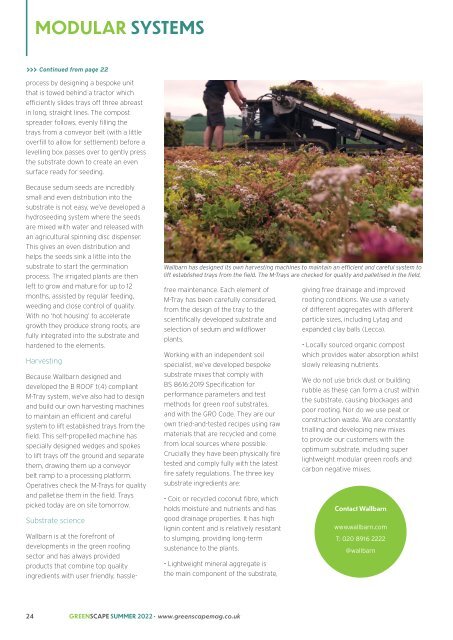Summer '22
You also want an ePaper? Increase the reach of your titles
YUMPU automatically turns print PDFs into web optimized ePapers that Google loves.
MODULAR SYSTEMS<br />
>>> Continued from page 22<br />
process by designing a bespoke unit<br />
that is towed behind a tractor which<br />
efficiently slides trays off three abreast<br />
in long, straight lines. The compost<br />
spreader follows, evenly filling the<br />
trays from a conveyor belt (with a little<br />
overfill to allow for settlement) before a<br />
levelling box passes over to gently press<br />
the substrate down to create an even<br />
surface ready for seeding.<br />
Because sedum seeds are incredibly<br />
small and even distribution into the<br />
substrate is not easy, we’ve developed a<br />
hydroseeding system where the seeds<br />
are mixed with water and released with<br />
an agricultural spinning disc dispenser.<br />
This gives an even distribution and<br />
helps the seeds sink a little into the<br />
substrate to start the germination<br />
process. The irrigated plants are then<br />
left to grow and mature for up to 12<br />
months, assisted by regular feeding,<br />
weeding and close control of quality.<br />
With no ‘hot housing’ to accelerate<br />
growth they produce strong roots, are<br />
fully integrated into the substrate and<br />
hardened to the elements.<br />
Harvesting<br />
Because Wallbarn designed and<br />
developed the B ROOF t(4) compliant<br />
M-Tray system, we’ve also had to design<br />
and build our own harvesting machines<br />
to maintain an efficient and careful<br />
system to lift established trays from the<br />
field. This self-propelled machine has<br />
specially designed wedges and spokes<br />
to lift trays off the ground and separate<br />
them, drawing them up a conveyor<br />
belt ramp to a processing platform.<br />
Operatives check the M-Trays for quality<br />
and palletise them in the field. Trays<br />
picked today are on site tomorrow.<br />
Substrate science<br />
Wallbarn is at the forefront of<br />
developments in the green roofing<br />
sector and has always provided<br />
products that combine top quality<br />
ingredients with user friendly, hassle-<br />
Wallbarn has designed its own harvesting machines to maintain an efficient and careful system to<br />
lift established trays from the field. The M-Trays are checked for quality and palletised in the field.<br />
free maintenance. Each element of<br />
M-Tray has been carefully considered,<br />
from the design of the tray to the<br />
scientifically developed substrate and<br />
selection of sedum and wildflower<br />
plants.<br />
Working with an independent soil<br />
specialist, we’ve developed bespoke<br />
substrate mixes that comply with<br />
BS 8616:2019 Specification for<br />
performance parameters and test<br />
methods for green roof substrates,<br />
and with the GRO Code. They are our<br />
own tried-and-tested recipes using raw<br />
materials that are recycled and come<br />
from local sources where possible.<br />
Crucially they have been physically fire<br />
tested and comply fully with the latest<br />
fire safety regulations. The three key<br />
substrate ingredients are:<br />
• Coir, or recycled coconut fibre, which<br />
holds moisture and nutrients and has<br />
good drainage properties. It has high<br />
lignin content and is relatively resistant<br />
to slumping, providing long-term<br />
sustenance to the plants.<br />
• Lightweight mineral aggregate is<br />
the main component of the substrate,<br />
giving free drainage and improved<br />
rooting conditions. We use a variety<br />
of different aggregates with different<br />
particle sizes, including Lytag and<br />
expanded clay balls (Lecca).<br />
• Locally sourced organic compost<br />
which provides water absorption whilst<br />
slowly releasing nutrients.<br />
We do not use brick dust or building<br />
rubble as these can form a crust within<br />
the substrate, causing blockages and<br />
poor rooting. Nor do we use peat or<br />
construction waste. We are constantly<br />
trialling and developing new mixes<br />
to provide our customers with the<br />
optimum substrate, including super<br />
lightweight modular green roofs and<br />
carbon negative mixes.<br />
Contact Wallbarn<br />
www.wallbarn.com<br />
T: 020 8916 2222<br />
@wallbarn<br />
24 GREENSCAPE SUMMER 2022 • www.greenscapemag.co.uk

















